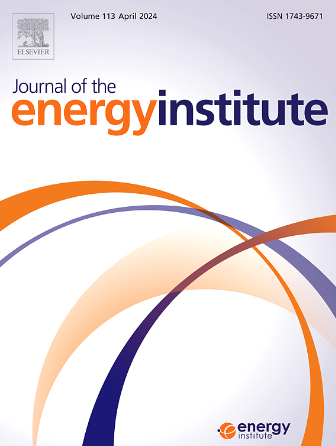铈诱导的镍沸石催化剂酸碱位点改性用于改进甲烷的干转化
IF 5.6
2区 工程技术
Q2 ENERGY & FUELS
引用次数: 0
摘要
甲烷干重整(DRM)是通过将 CH4 和 CO2 转化为有价值的合成气来减少温室气体排放的一条可行途径。本研究探讨了在以 CBV3020E(ZSM-5)为载体的镍基催化剂中添加 Ce 对 DRM 的影响。本研究首次详细探讨了如何使用 Ce 作为促进剂来调整用于 DRM 的沸石的酸碱特性。虽然 Ce 传统上一直被用于提高氧气储存能力,但这项研究探索了将其用作提高表面碱性和促进二氧化碳吸附的新方法。样品通过湿法浸渍制备,使用 N2 吸附、X 射线衍射、H2 温度编程还原、CO2 和氨的温度编程解吸以及傅立叶变换红外光谱进行表征,并在 800 °C 和 42,000 mL/g.h GHSV 条件下进行 DRM 测试。结果表明,ZSM-5 沸石有利于实现高金属分散。在 Ni5/ZSM-5 中引入 2 wt% 的 Ce 可提高强碱性位点的浓度,从而改善催化性能,使 Ni5/ZSM-5 的 CH4 转化率和 CO2 转化率分别从 37% 和 48% 提高到 55% 和 65%。因此,Ni5Ce2/ZSM-5 的效果最好,最佳 H2/CO 比率为 0.84。当 GHSV 降至 15,000 mL/g.h 时,Ni5Ce2/ZSM-5 上的 CH4 和 CO2 转化率分别跃升至 83 % 和 88 %。铈掺杂产生了更多理想的强碱性位点,提高了氧化镍的还原性。这促进了二氧化碳的吸附,并推动催化反应向合成气形成的方向发展,最终提高了效率和性能。本文章由计算机程序翻译,如有差异,请以英文原文为准。

Cerium-induced modification of acid-base sites in Ni-zeolite catalysts for improved dry reforming of methane
Dry reforming of methane (DRM) is a promising route to mitigate greenhouse gas emissions by converting CH4 and CO2 into valuable syngas. The present work explores the effect of Ce addition to Ni-based catalysts supported on CBV3020E (ZSM-5) for DRM. The use of Ce as a promoter to tune the acid-base properties of zeolites for DRM is addressed for the first time in detail. While Ce has traditionally been used to improve oxygen storage capacity, this work explores its novel use as a means to enhance surface basicity and promote CO2 adsorption. The samples were prepared by wet impregnation, characterized using N2-sorption, X-ray diffraction, H2-temperature-programmed reduction, temperature-programmed desorption of CO2 and ammonia, and Fourier transforms infrared spectroscopy, and tested for DRM at 800 °C and 42,000 mL/g.h GHSV. Results show that ZSM-5 zeolite can be beneficial in achieving high metal dispersion. The introduction of 2 wt% Ce to Ni5/ZSM-5 increases the concentration of strong basic sites, resulting in improved catalytic performance from 37 % CH4 conversion and 48 % CO2 conversion for Ni5/ZSM-5 to 55 % and 65 % on promoted Ni5Ce2/ZSM-5, respectively. Thus, the best results are observed on Ni5Ce2/ZSM-5 and an optimal H2/CO ratio of 0.84 is achieved in this case. Upon decreasing GHSV to 15,000 mL/g.h, CH4 and CO2 conversions jump to 83 % and 88 %, respectively on Ni5Ce2/ZSM-5. Cerium doping produces more desirable strong basic sites and enhances NiO reducibility. This promotes CO2 adsorption and drives the catalytic reaction towards syngas formation, which eventually results in increased efficiency and improved performance.
求助全文
通过发布文献求助,成功后即可免费获取论文全文。
去求助
来源期刊

Journal of The Energy Institute
工程技术-能源与燃料
CiteScore
10.60
自引率
5.30%
发文量
166
审稿时长
16 days
期刊介绍:
The Journal of the Energy Institute provides peer reviewed coverage of original high quality research on energy, engineering and technology.The coverage is broad and the main areas of interest include:
Combustion engineering and associated technologies; process heating; power generation; engines and propulsion; emissions and environmental pollution control; clean coal technologies; carbon abatement technologies
Emissions and environmental pollution control; safety and hazards;
Clean coal technologies; carbon abatement technologies, including carbon capture and storage, CCS;
Petroleum engineering and fuel quality, including storage and transport
Alternative energy sources; biomass utilisation and biomass conversion technologies; energy from waste, incineration and recycling
Energy conversion, energy recovery and energy efficiency; space heating, fuel cells, heat pumps and cooling systems
Energy storage
The journal''s coverage reflects changes in energy technology that result from the transition to more efficient energy production and end use together with reduced carbon emission.
 求助内容:
求助内容: 应助结果提醒方式:
应助结果提醒方式:


